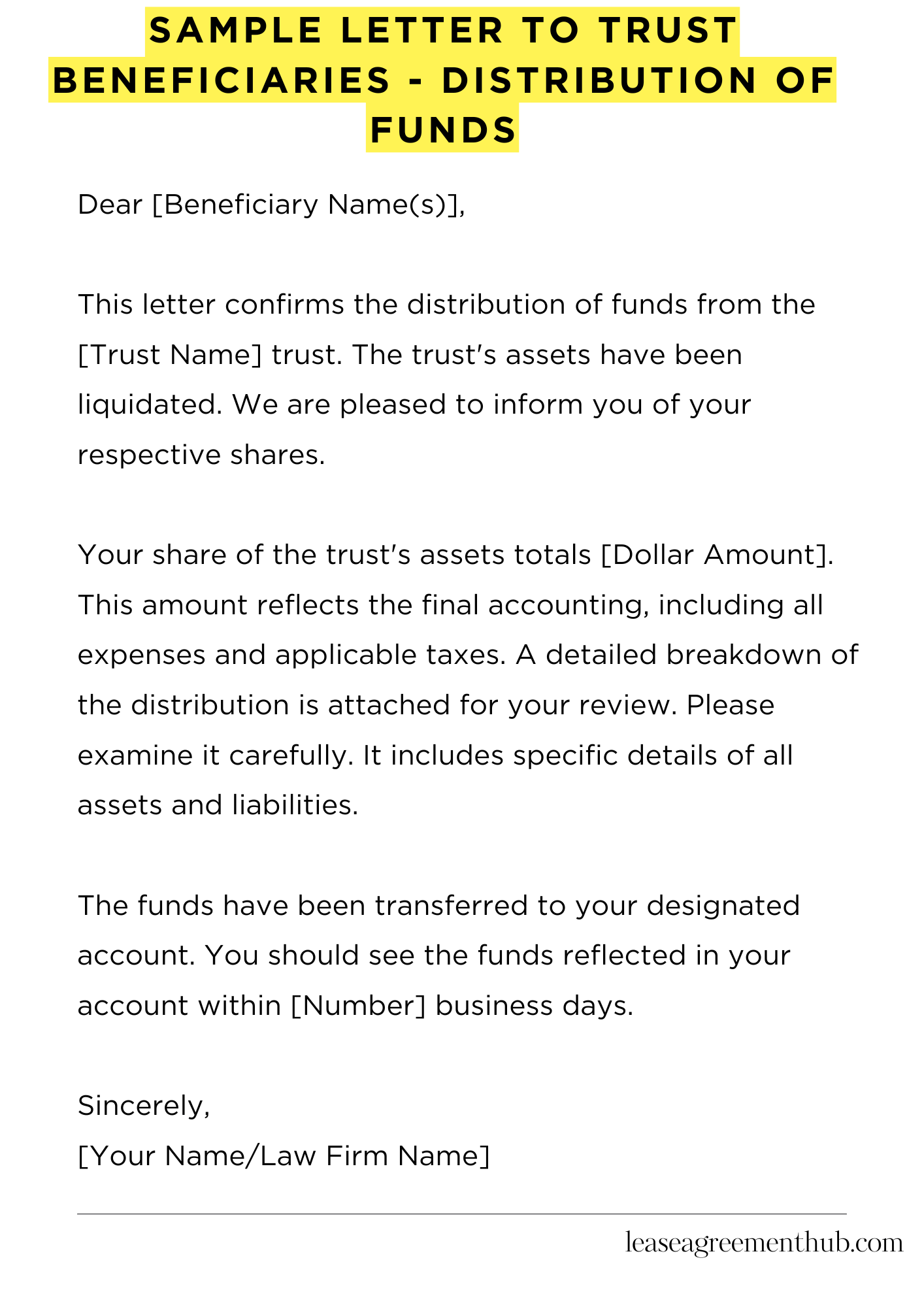A sample letter to trust beneficiaries about distributing funds is a template. It helps trustees communicate with beneficiaries. It explains how trust funds will be distributed.
This article gives you examples of these letters. We provide various templates. You can adapt them to your specific situation.
Use our samples to write your own letter. Save time and effort. Ensure clear communication with beneficiaries.
Sample Letter to Trust Beneficiaries – Distribution of Funds
[Your Name/Law Firm Letterhead]
[Date]
[Beneficiary Name(s)]
[Beneficiary Address(es)]
Dear [Beneficiary Name(s)],
This letter confirms the distribution of funds from the [Trust Name] trust. The trust’s assets have been liquidated. We are pleased to inform you of your respective shares.
Your share of the trust’s assets totals [Dollar Amount]. This amount reflects the final accounting, including all expenses and applicable taxes. A detailed breakdown of the distribution is attached for your review. Please examine it carefully. It includes specific details of all assets and liabilities.
The funds have been transferred to your designated account. You should see the funds reflected in your account within [Number] business days. If you have not received the funds by [Date], please contact us immediately. We will investigate the matter promptly.
We understand that receiving such funds can be a significant event. We are here to answer any questions you may have. Do not hesitate to contact us if further clarification is needed. We are committed to providing you with the best possible service.
Sincerely,
[Your Name/Law Firm Name]

How to Write a Sample Letter to Trust Beneficiaries – Distribution of Funds
Understanding Your Audience: A Crucial First Step
Before even considering phrasing, identify your audience. Are they sophisticated investors accustomed to trust administration minutiae, or are they individuals less familiar with financial jargon? Tailor your tone and vocabulary accordingly. Clarity is paramount; avoid obfuscation. Employing excessively technical terminology could sow confusion and engender mistrust.
Structuring Your Letter for Clarity and Impact
A well-structured letter is easier to understand and more persuasive. Begin with a concise salutation, followed by a clear and unambiguous statement of purpose. Subsequent paragraphs should detail the distribution plan methodically, citing relevant clauses from the trust document to bolster your claims. This lends an air of probity to the process.
Detailing the Distribution Plan: Precision is Key
Ambiguity is the nemesis of trust administration. Specify the exact amounts allocated to each beneficiary, the method of disbursement (e.g., direct deposit, check), and the anticipated timeline. Include any conditions attached to the distribution, such as educational stipulations or age-related restrictions. Provide supporting documentation where applicable, such as bank statements or receipts. This meticulous approach minimizes potential disputes and underscores transparency.
Addressing Potential Contingencies: Proactive Mitigation
Anticipate potential questions or concerns. A proactive approach demonstrates foresight and minimizes misunderstandings. Address common queries regarding tax implications, future distributions, or the administration of the trust itself. Including a contact person for further inquiries further enhances the letter’s efficacy. This proactive measure fosters trust and bolsters confidence.
Maintaining a Professional and Empathetic Tone
While maintaining a precise and formal tone, remember the human element. A letter devoid of empathy can feel impersonal and uncaring. Acknowledge the beneficiaries’ circumstances and express your understanding of the sensitive nature of the matter. A touch of compassion goes a long way in mitigating potential anxieties.
Legal Considerations: Protecting Yourself and the Beneficiaries
Seek legal counsel before finalizing the letter. Ensure compliance with all relevant laws and regulations pertaining to trust distribution. This step protects both yourself and the beneficiaries from future complications arising from legal non-compliance. This is a crucial safeguard, mitigating potential litigation.
Review and Revision: A Necessary Final Step
Before dissemination, meticulously review the letter for any errors. A proofread, polished document conveys professionalism and competence. A second pair of eyes—ideally, someone with legal or financial expertise—can identify potential oversights. This prudent measure minimizes the risk of errors and reinforces the message’s impact. Consider seeking a legal review for ultimate assurance.
FAQs about sample letter to trust beneficiaries – distribution of funds
What information should a letter to trust beneficiaries about fund distribution include?
A letter to trust beneficiaries regarding fund distribution should clearly state the date of distribution, the amount distributed to each beneficiary, the method of distribution (e.g., check, wire transfer), and any relevant tax information or reporting requirements. It should also reference the trust document itself for context and legal standing.
How formal should the letter be?
The letter should maintain a professional and formal tone, reflecting the legal and financial nature of the transaction. While clarity is paramount, overly complex legal jargon should be avoided in favor of plain language.
What if a beneficiary’s contact information is outdated?
If a beneficiary’s contact information is outdated, the trustee should make reasonable efforts to locate the beneficiary using available resources. This might involve contacting family members, searching public records, or engaging a professional locator service. Documentation of these efforts should be maintained.
What should the letter do if there are disagreements among beneficiaries?
The letter should acknowledge any existing disputes or disagreements among beneficiaries regarding the distribution, but should not attempt to resolve them within the letter itself. It should clearly state the trustee’s actions based on the trust document and advise beneficiaries to seek legal counsel if necessary.
Is it necessary to have a lawyer review the letter before sending it?
While not always legally required, having a lawyer review the letter before distribution is highly recommended. This ensures compliance with all legal requirements and minimizes the risk of future disputes or challenges to the distribution.
Related: